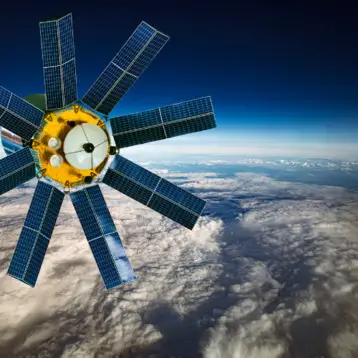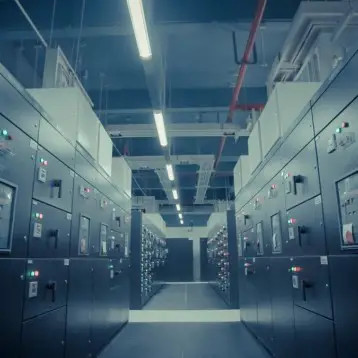Recent advancements might finally open the door to a new storage technology that will merge optical and magnetic technologies, leading to high capacity storage devices reaching speeds thousands of times that of existing storage technologies, while boasting improved reliability.
 |
Magneto-optical imaging set-up
(Credit: Daniel Stanciu) |
|
In 2006 Dr. Daniel Stanciu (then working on his Ph.D.) and Dr. Fredrik Hansteen discovered a way to use light to change the polarity of a magnet. Even more impressive was the fact that it only took an extremely short laser pulse of about 40 femtoseconds (an unimaginably short time equal to one millionth of a nanosecond) in order to switch a magnet. According to Stanciu, back in 2006, conventional wisdom in the field considered this feat to be impossible. Even Stanciu’s Professor did not believe the young researcher until the latter demonstrated the switch in the lab.
At the time switching magnets with lasers was considered impossible and even after it was shown to work; the conventional physical theory was unable to explain it. Since then, several groups of physicists across the world have been working on setting the theoretical basis for this innovative research, and there has been progress in explaining the phenomena now called all-optical magnetization reversal.
 |
Schematic drawing of the time-resolved
pump-probe experimental set up used
to study ultrafast magnetization dynamics
(Credit: Daniel Stanciu) |
|
In many respects the story behind the discovery of the optical magnetization reversal is similar to the development of the first Maser (which stands for ‘Microwave Amplification by Stimulated Emission of Radiation’ and predated the first laser). In the early 1950s Charles Townes, a Colombia University physicist, was working on spectroscopy and microwave physics research (an interest he developed partially as a result of his World War II work on the radar). Townes (and independently – two Soviet physicists) came up with the concept of the maser. The maser, which emits coherent electromagnetic waves (in the microwave spectrum) by stimulated emission, was a novel idea and at the time many scientists (including very prominent ones) did not believe such a device was even possible in theory (let alone the possibility of actually constructing one).
In his
biography, Townes mentions a story that happened a short time after the maser was demonstrated: “In 1954, shortly after [James] Gordon and I built our second maser and showed that the frequency of its microwave radiation was indeed remarkably pure, I visited Denmark and saw Niles Bohr. As we were walking along the street together, he asked me what I was doing. I described the maser and its amazing performance. “But that is not possible!” he exclaimed. I assured him it was. Similarly, at a cocktail party in Princeton, New Jersey, the Hungarian mathematician John von Neumann asked what I was working on. I told him about the maser and the purity of its frequency. “That can’t be right!” he declared. But it was, I replied, telling him it had already been demonstrated. Such protests were not offhand opinions about obscure aspects of physics; they came from the marrow of these men’s bones”.
Stanciu’s story seems remarkably similar to the maser. An all-optical magnetization reversal was considered impossible until it was actually demonstrated in the lab. Physicists needed some convincing before they would even consider the idea, but once it gained the scientific community’s seal of approval applications started to appear rapidly.
 |
An illustration demonstrating of compact
all-optical recording of magnetic bits
(Credit: Daniel Stanciu) |
|
In the case of optical magnetization reversal, one of the most obvious applications is super fast magnetic storage. This future type of magnetic/optical hybrid will not only potentially be thousands of times faster than any existing magnetic storage technology, it could also remove the need for the rotating disk (platter) used by every hard drive since the original IBM 305 RAMAC in the mid 1950s. This change could considerably increase the reliability of magnetic storage, which until now has been hampered by occasional mechanical failures.
In an interview TFOT recently conducted with Stanciu, he explained some of the issues facing this novel technique as well as some of its advantages. According to Stanciu, when he published the initial results of his research there were two main challenges facing the actual implementation of the technology:
- How can Femtosecond lasers (being large and extremely expensive) be integrated into the small (and fairly inexpensive) form factor of a conventional hard drive?
- How should high density data storage be reached? Using light to switch a very specific part of the drive required focusing light well below micron level while maintaining the laser beam’s circularly polarized light (that is photons with angular momentum) unchanged. This is because in order to switch a magnet the researchers changed the polarization of light from left to right (or the other way around). At that time, (2007) plasmon antennas – devices that can focus the light well below its wavelength (e.g. down to 50 nanometers) – were already available. However, when focusing the light through these plasmon antennas, the light polarization was lost.
However, since 2007 both challenges have been overcome:
- During an internship at Seagate in 2007 Stanciu and his colleagues considered switching magnets using picosecond pulses instead of femtosecond. Since picosecond lasers are far cheaper than their femtosecond counterparts and are also small enough to be implemented into real storage devices they could prove to be a perfect initial solution. Stanciu and a team at Seagate successfully tested this idea and proved their feasibility (the results of this effort are currently waiting for publication).
- According to Stanciu, the second challenge was recently solved as well by the research group of Professor Thomas Ebbesen in Strasbourg, France. They succeeded in building plasmon antennas that can behave as quarter wave plates, and therefore focus circularly polarized light for high density data storage.
 |
Laser-Induced Femtosecond
Magnetic Recording Illustration
(Credit: Daniel Stanciu) |
|
Although both major challenges have been solved, Stanciu still believes that it will take the industry approximately 5 more years before we can actually see commercial laser-hard drive hybrids. Even with the cheap picosecond lasers existing today, a laser hard drive could reach a phenomenal speed of about 1 TBits/s. In comparison, a top of the line hard drive today can reach a data transfer rate of about 1GBits/s, and advanced solid state flash drives can reach about 2-3 times that speed. In the more distant future femtosecond based laser drives could potentially reach unimaginable speeds of up to 100TBits/s and beyond.
More information on Dr. Daniel Stanciu and his work can be found on his personal
webpage.














